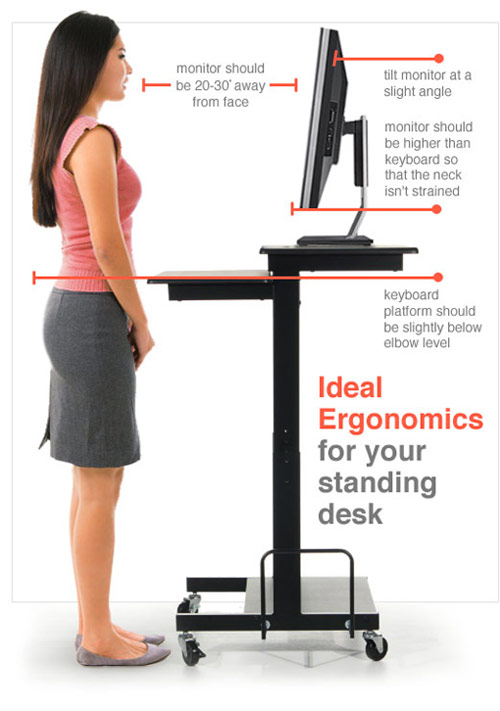Take a Stand at Work
July 10, 2013
Making it a point to stand up at least every 30 minutes at work can make a big impact on your rehabilitation as well as utilized as a prevention strategy. Prolonged sitting allows your hamstrings and hip flexors to tighten and your low back muscles to become weak. Sitting posture plays a huge role in contributing to low back pain for those who sit continuously at work. In addition, prolonged sitting postures can hinder the discs in your spine from receiving proper nutrients needed to maintain proper spine health. Standing and movement allows proper flow of blood and nutrients to your discs and muscles throughout your body. Standing workstations have become a more popular solution over the past few years to help alleviate or prevent low back pain from occurring at work.
People have actually opted for and now utilize a standing workstation. When utilizing a standing workstation be sure to not slouch. You also want to have your weight balanced on both feet. However, if you are suffering from heart disease, please consult your doctor before considering a standing workstation. Pictured below is an example of a standing workstation by Balt:
If you are unable to obtain a standing workstation due to a budget or space here are some tips to improving your posture at work.
Keys to Improving your Posture at Work:
- Select or adjust your chair that allows you keep your feet flat on the floor. The height should be adjusted so that your knees are level with your hips. You may need a stool under your feet if your desk chair cannot be adjusted.
- Roll up a towel and place it vertically behind your back.
- Remove any items from your back pockets such as keys or your wallet that may cause your pelvis to tilt in sitting.
- If you are holding a phone for several hours per day at work, it may be useful to invest in a headset.
- Sometimes analogies may work best to allow you to be mindful. Pretend you are being held up by a string. This can automatically help you to sit up.
Not only is prolonged sitting bad for your back, it’s bad for your health. Excessive sitting can lead to cardiovascular disease, diabetes, and cancer. It’s important to always break up sedentary periods of prolonged sitting with movement even if it’s not at work. Movement is key to reducing your back pain and improving your health.













